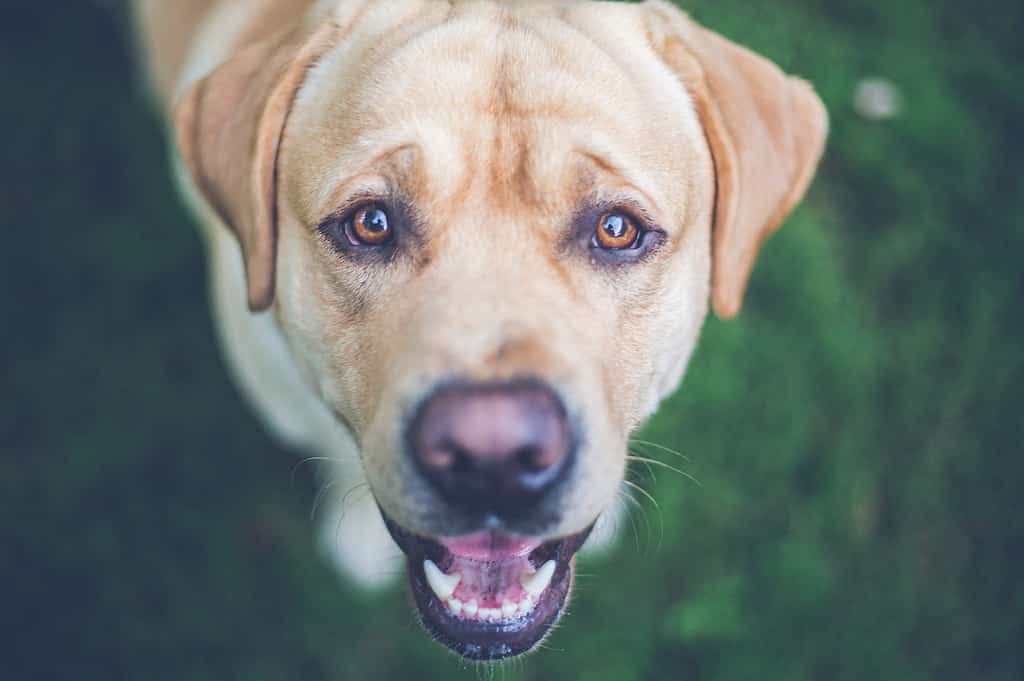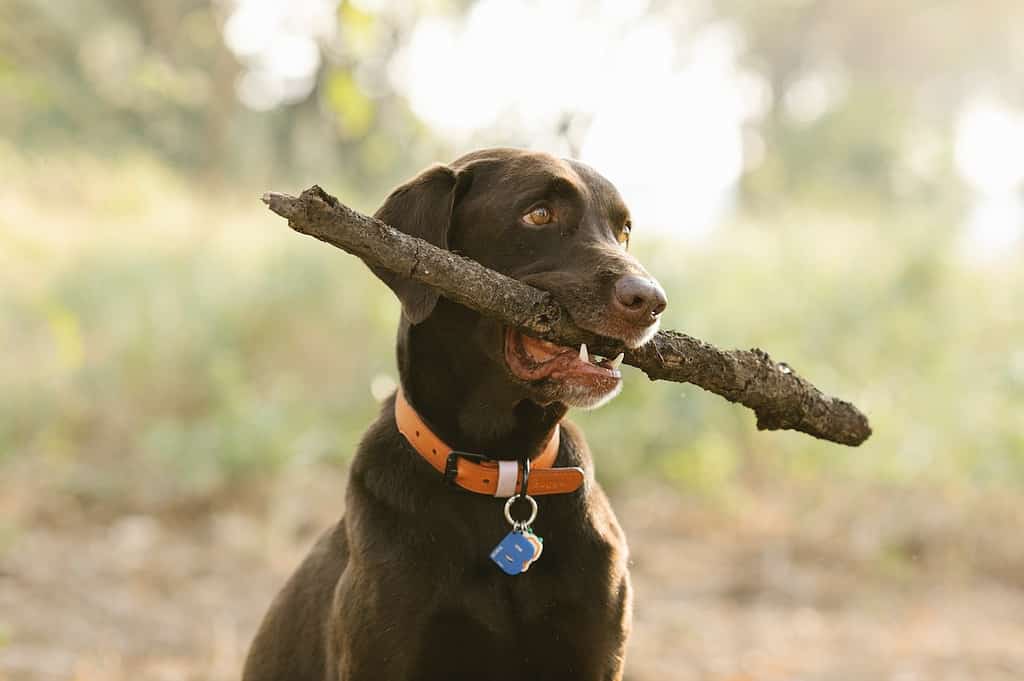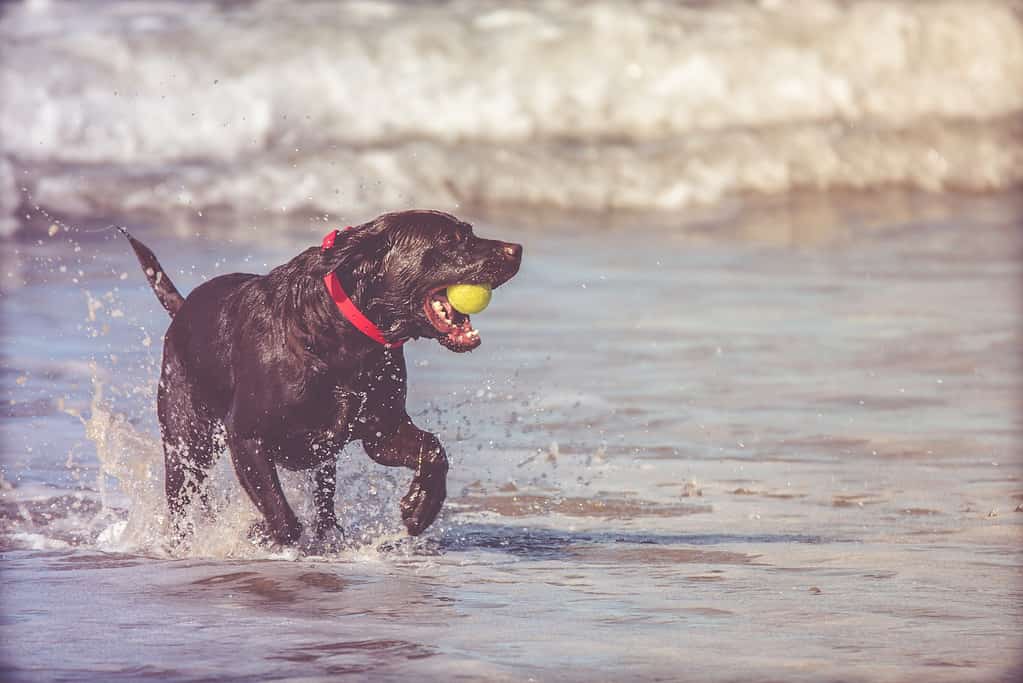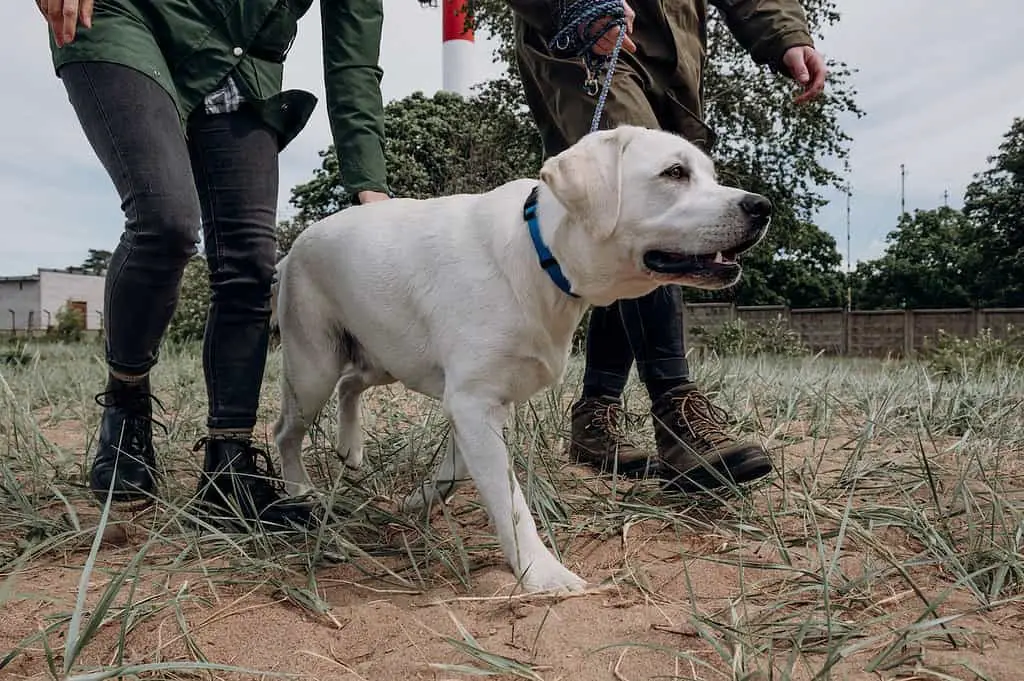Labrador Retrievers have friendly and outgoing behavior. Their behavior can change with age depending on training, socialization, and health. A well-trained and socialized Labrador Retriever will typically exhibit good behavior throughout life.
Labradors may become less active and more prone to specific health issues as they age. Older dogs may exhibit changes in behavior, like increased anxiety or aggression. To maintain good behavior in an aging Labrador Retriever, provide regular exercise, mental stimulation, and routine veterinary care.

lab puppy behavior stages
The behavior of Labradors varies greatly depending on their age. Understanding these different stages is essential for pet owners. Here is an outline of the key phases, from the birth weeks to their senior years.
The First Two Weeks After Birth
Labrador puppies experience the “newborn puppy growth stage” in the first two weeks. The Labrador puppy is completely dependent on their mother for warmth and nourishment.
They spend most time sleeping and feeding, which aids in their physical development. Pet owners must ensure a safe and cozy environment for the mother dog and her litter. A warm whelping box provides a comfortable living space for newborns.
From 2 Weeks To 1 Month
Labrador Retriever puppies undergo significant changes during the developmental stage (2 weeks to 1 month old). These adorable pups start opening their eyes in the second week. They waddle around slightly, learning to coordinate their tiny legs for locomotion. Lab puppies’ senses are further developed when they are three weeks old.
Their natural curiosity prompts them to explore new smells, sounds, and tastes. It is normal canine behavior to set the foundation for future interactions with people and other dogs. Gradually transitioning into new experiences during this stage helps shape their temperament.

From 4 Weeks To 7 Weeks
They start interacting with littermates, other dogs, and humans during this time. As early as four weeks, these pups exhibit key traits like playfulness, intelligence, and friendliness.
The puppies are introduced to foundational obedience training in this phase. It includes basic commands and proper etiquette around food or toys. Rescue dogs or pups from inexperienced breeders may display destructive behavior. It happens when mental and physical stimulation opportunities are not offered during this stage.
From 8 Weeks To 12 Weeks
Your Labrador Retriever puppy is becoming more independent and curious. They will start to explore further from their mother and littermates. This exploration period is vital for a well-rounded labrador retriever. It helps them develop confidence in new situations. During this time, it’s also critical to provide consistent obedience lessons.
Start with basic commands such as “sit” and “stay.” Establishing boundaries early on helps avoid unwanted behaviors later in life. At 12 weeks old, your Lab puppy should weigh around 20-30 pounds. The actual weight depends on the sex of the dog breed.
Their double coat may become more noticeable at this age. They’ll need regular grooming to prevent matting or tangling.
From 3 To 4 Months
Labrador Retriever is in the middle of the socialization period, around 3 to 4 months old. They learn about the world through exploration and interaction.
Exposing them to different people, places, and things is important. Your puppy may also develop unwanted habits like biting or excessive barking. This is a part of normal canine behavior. Nothing to worry about.
Address these behaviors by redirecting their attention toward chew toys. Also, provide enough mental stimulation to the labrador retriever through dog sports, brain training, fetch game or walks. Consistency is key. Regular practice will yield better results than sporadic sessions.

From 3 To 6 Months
The puppy grows quickly during this stage. They understand basic commands and respond to positive reinforcement training. Provide plenty of mental stimulation through toys, various activities, and continuing socialization.
This is the best time to introduce bite inhibition training for an individual dog to condition them better and remove any existent behavior problems. It develops good communication skills and reduces the likelihood of aggressive behavior.
From 6 To 18 Months
Your energetic adolescent Labrador Retriever will test boundaries and push limits between 6 and 18 months. The so-called “teenage” months can be a trying time for pet owners. Due to pent-up energy, labs may display excessive barking, digging, or destructive chewing.
Do not give up on training, even during this period, for it helps reinforce good habits over bad ones. Positive reinforcement techniques encourage acceptable behaviors in Labs within this age range.
2-year-old labrador behavior To 7 Years
Your Labrador Retriever is fully grown and weighs 55-80 pounds when 18 months. They benefit from regular exercise, playtime, training, or puzzle toys. Never forget to add different sets of exercises. Your Lab will enter their senior years as they reach seven years old.
They’re less active than before but require enough daily physical activity to maintain muscle mass. Exercise also slows down age-related issues like arthritis or hip dysplasia. Ensure their nutritional needs are met during these years. Go for Royal Canin Senior for their food, as this brand is specially made for a labrador retriever.

From 7 To 10 Years
Your Labrador Retriever is considered a senior dog between ages 7 and 10. You will see a gradual slowdown in their activity levels.
They might experience health problems like vision impairment, joint pain, hearing loss, dryness, or itchiness. Monitor what your senior labrador eats since older dogs require fewer calories than younger ones. Switch from regular dog food to senior-specific kibble that accommodates aging needs.
Things To Consider Before Choosing A Labrador Retriever
Ask yourself first
Do you have the time and commitment to properly care for a Labrador Retriever?
– They require lots of exercises, mental stimulation, training, and grooming.
Can you provide enough space and financial resources for a Lab throughout its life stages?
-Consider your preferred age range (puppy or adult dog).

Time And Commitment
Considering the time and commitment involved when becoming a dog parent is essential.
- Daily Exercise: This dog breed requires at least an hour of daily exercise. Without sufficient exercise and mental stimulation, they can develop destructive behaviors.
- Feeding Time: Establish a feeding routine for your deep-chested dogs by setting aside specific meal times during the day. This helps with digestion and prevents overeating.
- Puppy Training: Puppies require patience and consistent training to learn good behavior. This takes time and effort on your part.
- Grooming & Health Care: Labs have double coats that shed consistently. Grooming them regularly helps. They need regular veterinary check-ups, vaccinations, and treatments for health problems.
- Emotional Support: As social creatures, this dog breed craves attention from their human family member. They can suffer from separation anxiety if left alone for too long regularly.
Space And Costs
Consider the space and costs associated with owning a Labrador retriever. Labs require ample space for exercise and play. This includes a yard or access to a dog park where they can run around freely. Ensure the living space is safe for your Labrador retriever. Remove sharp objects out of their reach. It will be almost akin to carrying for a human baby

Puppy Or Adult Dog
When considering bringing a Labrador Retriever, you can choose between a puppy or an adult dog. Each has its advantages and disadvantages.
1. Time and Commitment:
- – Puppies require more time and attention than adult dogs.
- – Adult dogs may already be trained or have fewer behavior problems. They mostly exhibit mature behavior.
2. Space and Costs:
- – Puppies need space to run around and play, while adult dogs may be content with less exercise.
- – Puppies will require more supplies and may have higher veterinary costs.
3. Long-Term Relationship:
- – A puppy will grow into an adult dog, so consider the long-term commitment.
- – An adult lab may already have established habits that you may need to work on changing.
4. Separation Anxiety:
Puppies can suffer from separation anxiety if not trained properly. Adults may already be accustomed to being alone for periods. This can cause bad behavior problems in a labrador retriever. Proper training is key to removing this excessive fear of being alone.
5. Adoption Costs:
Puppies are usually more expensive to adopt than adults. But this can vary depending on the source.
6. Training and Grooming Needs:
- – Most puppies require obedience lessons and socialization, whereas adults may already be trained.
- – Both puppies and adults require regular grooming.
7. Other Pets in the Home:
Introducing a puppy to other pets requires careful supervision. An adult dog may adjust more easily. A puppy is spirited and has a winning personality.

Long-Term Relationship
Consider the long-term relationship that you will have with this energetic breed. This dog breed is incredibly social and loves being around its family members. You should have enough time and energy to devote to their care.
Take part in walks, runs, or even swimming to strengthen the bond. As they age, engaging in these activities prevents boredom or destructive behavior in many labs. If you cannot provide regular attention, it may be best not to adopt now. They form deep bonds with their family, and re-homing them is difficult.
Separation Anxiety
Separation anxiety is a common problem among Labradors. It can lead to certain behaviors which are unwarranted. Here are some signs indicating separation anxiety in Labs:
- Destructive behavior: Does your Lab start destroying things in your absence, like chewing up pillows or furniture? This is a behavior problem.
- Excessive barking: Labs with separation anxiety may bark excessively when left alone. This barking can be a sign of fear and distress in most labs.
- Trying to escape: A physically anxious dog may try to escape its crate or home when left alone.
- House training regression: Your Lab could suddenly have accidents when left alone.
- Depression: Separation anxiety can make your Labrador Retriever depressed. It leads to lethargy and a lack of energy.
Here are some tips to address these issues:
- Slowly acclimatize them to being alone by starting with short periods. Gradually increase their duration.
- Create a relaxing environment by playing soft music or using an oil diffuser.
- Provide plenty of exercise and mental stimulation before leaving so they feel tired.
- Provide suitable toys they enjoy playing with while you’re away.
- Consider enrolling your dog in obedience classes. Seek professional help if their anxiety continues.

Adoption Costs
The adoption fees can range from $50 to $500, depending on the dog’s age and health. This is just one of several expenses you will incur as a pet owner. Factor in costs such as vet exams, vaccinations, and spay or neuter surgery.
Purchasing a Labrador Retriever puppy from a breeder will get you guarantees and a breed certificate. It can be quite expensive, with average prices ranging from $800 to $1,200. Get more information from the National Breed Club and the American kennel club.
Training And Grooming Needs
Labrador Retrievers have specific training and grooming needs.
Early Socialization:
Labrador Retrievers require early socialization due to their friendly nature. It conditions the dog’s behavior to interact properly with people and other animals.
Obedience Training:
Labradors are medium to large dog breeds. Obedience lessons teach them proper behavior and manners while on or off leash. They can even make good assistance dogs.
Exercise and Mental Stimulation:
Labradors have high energy levels. Long walks, quality playtime, and canine sports like agility or retrieving work keep them fit.
Grooming:
This dog breed has a double coat that requires regular brushing. They also shed heavily twice a year, which needs extra care in grooming. Bathing is necessary for keeping their coat healthy and clean.
Nail Trimming:
Labradors stay busy all the time. Their nails can often naturally stay short by constant walking or playing on abrasive surfaces. Regular nail trimming is needed if you hear them clicking on the floor.
Dental Care:
Dental care is crucial to maintaining overall Labrador’s health. Brushing their teeth several times per week prevents oral diseases.

History Of The Dog Breed
The Labrador Retriever has a rich history traced back to the island of Newfoundland in Canada. They were originally bred as water dogs by early fishermen. These hardworking dogs would swim into the icy waters to retrieve fish and other items from the nets.
The dog breed was later introduced to Britain in the 1830s. They quickly gained popularity as versatile hunting dogs. According to the American Kennel Club, they were the most popular dog breed till 2023, when they lost the title to the French Bulldog. They will love their family members and have a life expectancy of 10-12 years

Other Pets In The Home
Before choosing a Labrador retriever, it’s important to consider any other pets in the home.
Size and Temperament:
Consider the size and temperament of your existing pet(s) compared to that of a Labrador retriever. These dogs have high energy and playful nature, which may not be suitable for all pets. If you have small animals like cats, you need to know how to introduce them
Introduction:
Proper introduction is key when bringing a new pet into a home with existing pets. Introduce them to neutral territory and under close supervision.
Socialization:
Early socialization is important for the Labrador retriever puppy and existing pets. It will prevent behavior problems and promote positive relationships.
Separate Spaces:
Provide separate spaces for each pet to eat, sleep, and play. It will avoid conflict and promote harmony. Many labs bond well with cats and other breeds.
Training:
Proper training will condition your lab and prevent any labrador retriever behavior that can threaten the lab or the pet.
Common Labrador Retrievers Behaviors
Labrador Retrievers have some common dog behaviors. It includes excessive licking, nibbling on objects or people, lip licking, and barking.
Licking
Labradors have an affectionate nature, and licking is one of the ways they show it. However, there may be various behavioral reasons behind it:
- Seeking attention: If your Labrador retriever feels ignored or wants to play, it may start licking you.
- Excitement: Meeting new people or going to a new place can cause over-excitement, leading to excessive licking.
- Boredom: If left alone for extended periods without enough stimulation, Labradors can lick excessively.
- Grooming: Licking themselves or others is also a way for Labradors to clean themselves.
- Stress: Licking can sometimes be a coping mechanism for stress.
Nibbling
Labrador puppies are known for their high play drive. When this dog plays, it loves to fake bite. It often leads to nibbling behavior. While this behavior is normal in puppies, train them to stop this habit as they mature. Nibbling doesn’t only occur during puppyhood. Adult Labradors may also nibble out of boredom, anxiety, or other reasons.
Lip Licking
Labradors may lick their lips. It can be a way to show affection or seek attention. Boredom, stress, excitement, grooming, or habit are other reasons. Lip licking can also indicate nausea, allergies, or dehydration in dogs. Some tips to address this behavior include:
- Providing enough brain training to condition them over other breeds
- Encouraging positive behaviors through training and rewards
- Identify potential sources of stress or anxiety and address them with professional help if needed
- Ensuring that your Labrador gets enough fluids daily to prevent dehydration
Barking
Labrador Retrievers are moderate barkers. They may bark to greet their owner, alert them of a potential threat, or communicate with other dogs. Address unwanted barking early on through positive reinforcement training. Provide enough physical activity and playtime.
Certain breeds chase prey due to their hunting background. Pet owners must understand these dogs have a retrieving ancestry and love chasing. Barking is normal behavior for dogs, but if you see abnormal barking, you must take steps to understand what is going wrong and address it.

Tips For Addressing Common Labrador Retriever Behaviors
Encourage positive behavior and provide consistent training. Offer enough exercise and mental stimulation, and seek professional help if needed.
Encourage Positive Behavior
Encourage positive behavior in your Labrador Retriever by focusing on rewarding good actions. Avoid punishing bad ones.
Positive reinforcement can lead to a happier and well-behaved dog. If your Lab sits when asked, reward them with treats or praise. Give them attention and affection if they chew on an appropriate toy instead of the furniture.
Consistent Training
Training is important to own a Labrador Retriever, and consistency is key to success.
- Establish clear expectations: Set clear boundaries and rules from the beginning of training sessions. Your dog will know what is expected of them.
- Schedule regular training sessions: Practice training consistently or every other day.
- Be patient: Training takes time and patience. Don’t get discouraged if progress seems slow at first.
- Keep it fun: Incorporate play into training sessions and make them enjoyable. Make them understand how to react to loud noises and faint ones.
Provide Enough Exercise And Stimulation
Labrador retrievers are high-energy dogs that require ample exercise and stimulation. The amount of exercise varies by age. But all labs need daily walks, runs, or playtime outside. Younger labs may have more energy and require more exercise than older ones. As they age they get afflicted with hip dysplasia which is a common Labrador retriever illness
Mental stimulation is equally important for Labrador retrievers. These smart dogs thrive on learning new things and solving puzzles. Puzzle toys filled with treats or hide-and-seek games are excellent for molding the dog’s behavior to the expected standard.
Seek Professional Help If Needed
If you are struggling with your Labrador Retriever’s behavior, don’t hesitate to seek professional help. A veterinarian, a trainer, or a behaviorist can help.
- Some behaviors can signal underlying health issues that require medical attention. They include anxiety, aggression, or excessive barking.
- Some dogs may exhibit destructive behavior due to separation anxiety or pent-up energy. Training alone may not address these issues.
- Professional trainers or behaviorists can create a customized training program. It is tailored to your Lab’s specific needs and personality.
- If your dog exhibits aggressive behavior, seek professional help before the situation worsens.
Seeking professional help doesn’t mean you’re a bad pet parent. It means you want what’s best for your furry friend and family.

FAQs
At what age do Labradors calm down?
Labradors calm down between 2-4 years old. Every dog is unique and may reach this stage at different times.
How do you know if your Labrador is happy?
A happy Labrador will display a wagging tail and relaxed body posture. They may also engage in playful behavior. They may also show affection towards their owner, such as cuddling or licking.
When do labs stop chewing?
Most Labrador Retrievers will stop chewing destructively when they are around 2 years old. However, some dogs may continue to chew on inappropriate items throughout their lives.
What age do labradors stop chewing?
Labs typically stop chewing destructively between the ages of 18 and 24 months. However, there is a wide range of normal behavior, and some dogs may continue to chew until they are 3 years old or older.
When do labs mature?
Labs are generally considered fully mature by the time they are 3 years old. However, they may continue to grow and develop physically and mentally until they are 4 or 5.
When does a labrador puppy become a dog?
There is no one definitive answer to this question, as it varies depending on the individual dog. However, most Lab puppies are considered dogs when they are 6 months old. This is when they have reached most of their adult size and have developed most of their adult physical and behavioral characteristics.
What are the behavioral traits of a Labrador?
Behavioral traits of Labradors include being friendly, loyal, and intelligent. They are also known for being good with children and other animals. They have a strong desire to please their owners.
What is typical Lab puppy behavior?
Typical Lab puppy behavior includes being playful, energetic, and curious. They may also chew on objects or have accidents while house training.
Is a 2 year old Lab still a puppy?
A 2-year-old Labrador may no longer be a puppy. But they are still young and may exhibit some puppy-like behavior. They may also have started to mature and exhibit more adult-like behavior.
What are common behavior problems with Labradors?
Common behavior problems with Labradors include excessive barking, digging, chewing, and jumping up on people. These can often be addressed with proper training and exercise.
What are Labrador retrievers’ attitudes?
Labrador retrievers have a friendly, outgoing attitude and a strong desire to please their owners. They are also generally easy to train due to their intelligence.
What is typical lab puppy behavior?
Typical lab puppy behavior includes playfulness, high energy levels, and a love of exploring their environment. They may also chew on objects and require house training.
What makes a Labrador happy?
Labradors are happiest when they receive plenty of exercise, attention, and affection from their owners. They also enjoy having a job or task, such as retrieving or obedience training.
Are lab puppies difficult?
Lab puppies can be challenging due to their high energy levels. They need adequate attention and training. They can grow into well-behaved, loving dogs with proper care and training.
Are lab puppies well-behaved?
Lab puppies have the potential to be well-behaved with proper training and socialization. However, their high energy levels and curiosity require more attention and effort than other breeds.
What is the hardest age for a Lab puppy?
Adolescence ( 7 to 10 months ) is considered a challenging phase. However, there may be variations based on each dog. Most pet parents consider the period between 8 and 9 months peak.
Author Profile
- Site Owner And Planning Specialist
-
Aritra, the founder of Labradorandyou.com, is a lifelong dog lover whose passion ignited for Labradors for their loyalty and intelligence. With extensive research and personal experiences, Aritra has become a Labrador expert, offering a rich resource on the breed. Labradorandyou.com provides reliable, timely, and evidence-based information, including Labrador-specific product reviews, training techniques, and care tips.
Labradorandyou.com was born out of Aritra's passion and his desire to share his profound knowledge about the breed. The site serves as a comprehensive resource, offering a wealth of up-to-date information for Labrador owners and enthusiasts alike
Also by the author
 FAQNovember 17, 2023How To Adopt An Emotional Support Dog?
FAQNovember 17, 2023How To Adopt An Emotional Support Dog? Mix-BreedsNovember 16, 2023Red Labradoodle Ultimate Guide: Breed Facts, Care Tips
Mix-BreedsNovember 16, 2023Red Labradoodle Ultimate Guide: Breed Facts, Care Tips Top BreedersNovember 8, 2023Breeding Labradors: Everything You Need to Know
Top BreedersNovember 8, 2023Breeding Labradors: Everything You Need to Know FAQOctober 17, 2023Do Dogs Like Music? Researchers Say Yes! Find Out
FAQOctober 17, 2023Do Dogs Like Music? Researchers Say Yes! Find Out





